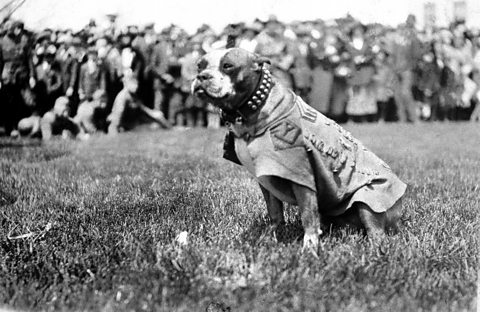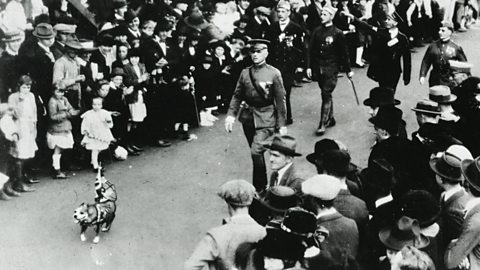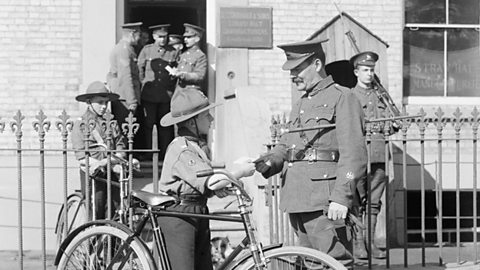Watch: Sergeant Stubby the war hero dog
Watch this animation for a short summary of Sergeant Stubby's life.
NARRATOR: Sergeant Stubby, courageous canine.
One day in 1917 some soldiers in America made friends with a dog after he wandered onto the field they were training in.
One of the soldiers, Corporal Robert Conroy, especially liked the dog and named him Stubby because of his short tail.
The USA joined World War One in 1917 and Corporal Conroy was sent to fight in France.
He didn’t want to leave Stubby so had him smuggled onto his ship.
Stubby had a greater sense of smell than the soldiers.
When he smelt gas he barked to warn the soldiers so that they could put on their gas masks in time.
He had excellent hearing and would move his tail to warn the soldiers that the enemy was approaching.
Stubby also searched the battlefield for injured soldiers. He would bark for help when he found one.
On the Western Front, Stubby was involved in many battles and also suffered from injuries.
He was made an unofficial Sergeant and was given many medals and awards for his bravery.
After the war, Stubby lived with his friend Corporal Conroy.
Stubby died in 1926 but is still remembered for helping so many soldiers in such a difficult time.
How did Stubby join the army?

- An American soldier called Corporal Robert Conroy saw Stubby wandering at his army base in 1917.
- He called him Stubby because of his short tail.
- When Conroy had to go and fight, he smuggled him on to the ship to France with him.

What did Stubby do during the war?

Sergeant Stubby took part in many battles, including the Battle of Marne.
- Stubby had great hearing and he knew when the enemy was coming, even from far away.
- He took on the role of a mercy dog, where he found and comforted dying and injured soldiers in battle.
- Dogs have a greater sense of smell than humans, so Stubby was able to detect the dangerous smell of gas before any of the human soldiers could.

How was Stubby honoured?

Image caption, Stubby marched through many parades
Stubby went to lots of marches and enjoyed the praise and attention he got from people all across the United States of America.
Image caption, Stubby had many shows and appearances
Stubby made numerous appearances at theatrical variety shows in America after the war, as seen in the poster above, which shows how well loved Stubby was to the public.
Image caption, Stubby even made an appearance at the White House
As seen in the newspaper report, Stubby actually made two appearances to the White House, where he met two US Presidents: President Harding and President Coolidge.
Image caption, Stubby earned a lot of medals for his services to war
It is hard to picture Stubby without his famous jacket. The jacket had many medals fixed on it, including the Purple Heart, the Republic of France Grande War medal and the Medal of Verdun.
1 of 4
Activity 1: Quiz – Who was Sergeant Stubby?
Play Bitesize games
Level up now! Take on the latest primary games on Bitesize.

More on World War One
Find out more by working through a topic
- count16 of 43

- count18 of 43

- count19 of 43
